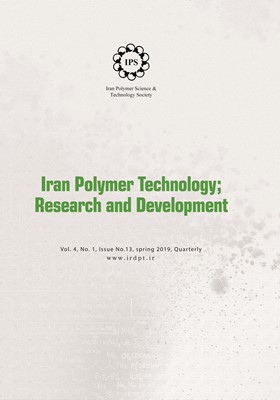review of the macromolecular and microorganism imprinting
Subject Areas :بیتا یاراحمدی 1 , seyed mohammad reza milani hoseini 2
1 -
2 -
Keywords: microorganism molecular imprinting polymer macromolecular ,
Abstract :
The term macromolecule refers to a group of molecules with a high molecular weight, composed of smaller units. Macromolecules contain proteins, amino acids, carbohydrates, etc., and play a very important role in the livelihoods, so the identification and detection of macromolecules is of particular importance. Different methods such as fluorescence, NMR, electron microscopy, electrophoresis and HPLC are used to identify and detect macromolecules. A quick and accurate method for detecting macromolecules ismolecular imprinting. Molecular imprinting is one of the most important methods for the detection and quantification of a variety of small molecules, macromolecules and microorganisms (bacteria and viruses). Different imprinting methods are used to detection macromolecules and microorganisms, including surface imprinting, microcontact impeinting and epitope imprinting.Molecular molding compared with other detection methods has features such as low cost, high detection capability, stability, low detection limit and stability. Due to these properties imprinted polymers are used in various fields such as chromatography, drug delivery, nanotechnology and sensor technology.
[1] Wulff, Günter., Molecular Imprinting in Cross‐Linked Materials With the Aid of Molecular Templates a Way Towards Artificial Antibodies, Angewandte Chemie International Edition in English, 34.17, 1812-1832, 1995. [2] Whitcombe, Michael J., Nicole Kirsch., Ian A. Nicholls., Molecular imprinting Science and Technology: a Survey of The Literature For The Years 2004–2011, Journal of Molecular Recognition, 27.6, 297-401, 2014. [3] Chen, Lingxin., Shoufang Xu., Jinhua Li., Recent Advances in Molecular Imprinting Technology: Current Status, Challenges and Highlighted Applications, Chemical Society Reviews, 40.5, 2922-2942, 2011. [4] Ge, Yi., Anthony PF Turner., Too Large to Fit? Recent Developments in Macromolecular Imprinting, Trends in Biotechnology, 26.4, 218-224, 2008. [5] Li, Songjun, et al., Size Matters: Challenges in Imprinting Macromolecules, Progress in Polymer Science, 39.1, 145-163, 2014. [6] Saylan, Yeşeren, et al., Surface Imprinting Approach For Preparing Specific Adsorbent For IgG Separation., Journal of Biomaterials Science, Polymer Edition, 25.9, 881-894, 2014. [7] Ayankojo, Akinrinade George, et al., Molecularly Imprinted Polymer Integrated With a Surface Acoustic Wave Technique For Detection of Sulfamethizole, Analytical Chemistry, 88.2, 1476-1484, 2016. [8] Wang, Shuangshou, et al., Affinity-tunable Specific Recognition of Glycoproteins Via Boronate Affinity-Based Controllable Oriented Surface Imprinting, Chemical Science, 5.3, 1135-1140, 2014. [9] Bernard, Andre, et al., Microcontact Printing of Proteins, Advanced Materials, 12.14, 1067-1070, 2000. [10] Ertürk, Gizem, et al., Real-time Prostate-Specific Antigen Detection With Prostate-Specific Antigen Imprinted Capacitive Biosensors, Analytica Chimica Acta, 891, 120-129, 2015. [11] Perçin, Işık, et al., Microcontact Imprinted Plasmonic Nanosensors: Powerful Tools in the Detection of Salmonella Paratyph, Sensors, 17.6, 1375, 2017. [12] Nishino., Hidekazu., Chin‐Shiou Huang., Kenneth J. Shea., Selective Protein Capture by Epitope Imprinting, Angewandte Chemie International Edition, 45.15, 2392-2396, 2006. [13] Slinchenko, Olena, et al., Imprinted Polymer Layer For Recognizing Double-Stranded DNA, Biosensors and Bioelectronics, 20.6, 1091-1097, 2004. [14] Ogiso, Masayo, et al., Detection of a Specific DNA Sequence by Electrophoresis Through a Molecularl Imprinted Polymer, Biomaterials 27.22, 4177-4182, 2006. [15] Sassolas, Audrey., Béatrice D. Leca-Bouvier., Loïc J. Blum., DNA Biosensors and Microarrays, Chemical Reviews, 108.1, 109-139, 2008. [16] Raitman, O. A., et al., Molecularly imprinted Polymer Matrices for Analysis of the Cofactor NADH: a Surface Plasmon Resonance Study, Doklady Physical Chemistry, Vol. 392. No. 4. MAIK Nauka/Interperiodica, 2003. [17] Diltemiz, S. Emir, et al., Molecularly Imprinted ligand-Exchange Recognition Assay of DNA by SPR System Using Guanosine and Guanine Recognition Sites of DNA, Sensors and Actuators B, 133.2, 484-488, 2008. [18] Saridakis, Emmanuel, et al., Protein Crystallization Facilitated by Molecularly Imprinted Polymers, Proceedings of the National Academy of Sciences, 108.27, 11081-11086, 2011. [19] Wang, Zonghua, et al., An ionic liquid-modified Graphene Based Molecular imprinting Electrochemical Sensor For Sensitive Detection of Bovine Hemoglobin, Biosensors and Bioelectronics, 61, 391-396, 2014. [28] Li, Li, et al., Photolithographic Boronate Affinity Molecular Imprinting: a General and Facile Approach for Glycoprotein Imprinting, Angewandte Chemie International Edition, 52.29, 7451-7454, 2013. [20] Kaulpiboon., Jarunee, Piamsook Pongsawasdi., Wolfgang Zimmermann, Altered Product Specificity of a Cyclodextrin Glycosyltransferase by Molecular Imprinting With Cyclomaltododecaose, Journal of Molecular Recognition, 23.5, 480-485, 2010. [21] Hamid, Nurul Atiqah Abdul, Synthesis of Molecularly Imprinted Polymer for Glucose Binding, Diss, UMP, 2014. [22] Silika, Zarah., Kajian Model Kinetik dan Isoterma, Glucose Sulfate Imprinted Polymer Prepared by Sol-Gel Process on Silica Microparticles Surface: Kinetic Modeling and Isotherm Studies, Malaysian Journal of Analytical Sciences, 19.4, 799-807, 2015. [23] Xie, Xiaoyu, et al., Preparation of Molecularly Imprinted Polymers Based on Magnetic Nanoparticles For The Selective Extraction of Protocatechuic acid From Plant Extracts, Journal of Separation Science 38.6, 1046-1052, 2015. [24] Schirhagl, Romana, et al, Separation of Bacteria With Imprinted Polymeric Films, Analyst, 137.6, 1495-1499, 2012. [25] Mujahid, Adnan, Peter A. Lieberzeit, and Franz L. Dickert, Chemical Sensors Based on Molecularly Imprinted Sol-Gel Materials , Materials, 3.4, 2196-2217, 2010. [26] Cohen, Tally, et al, Whole Cell Imprinting in Sol-Gel Thin Films For Bacterial Recognition in Liquids: Macromolecular Fingerprinting, International Journal of Molecular Sciences, 11.4, 1236-1252, 2010. [27] Jenik, Michael, et al, Sensing Picornaviruses Using Molecular Imprinting Techniques on a Quartz Crystal Microbalance, Analytical Chemistry, 81.13, 5320-5326, 2009. [28] Wang, Yantian, et al, Potentiometric Sensors Based on Surface Molecular Imprinting: Detection of Cancer Biomarkers and Viruses, Sensors and Actuators B: Chemical, 146.1, 381-387, 2010. [29] Diltemiz, Sibel Emir, et al, 4-Aminophenyl Boronic acid Modified Gold Platforms for Influenza Diagnosis., Materials Science and Engineering: C 33.2, 824-830, 2013.
[30] Altintas, Zeynep, et al, NanoMIP Based Optical Sensor For Pharmaceuticals Monitoring, Sensors and Actuators B: Chemical, 213, 305-313, 2015.


